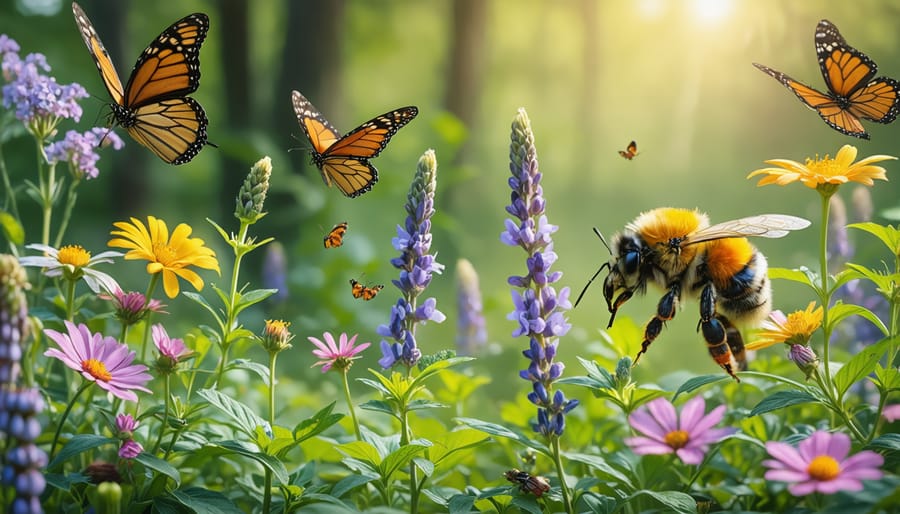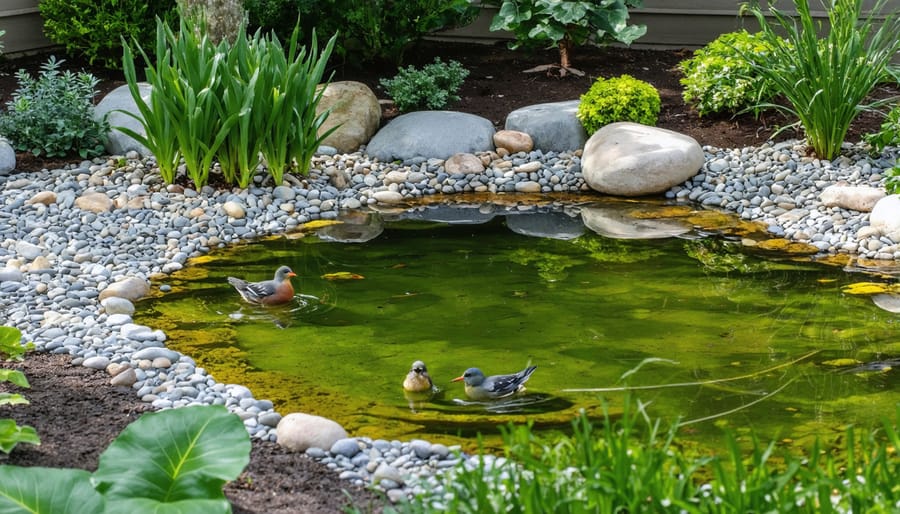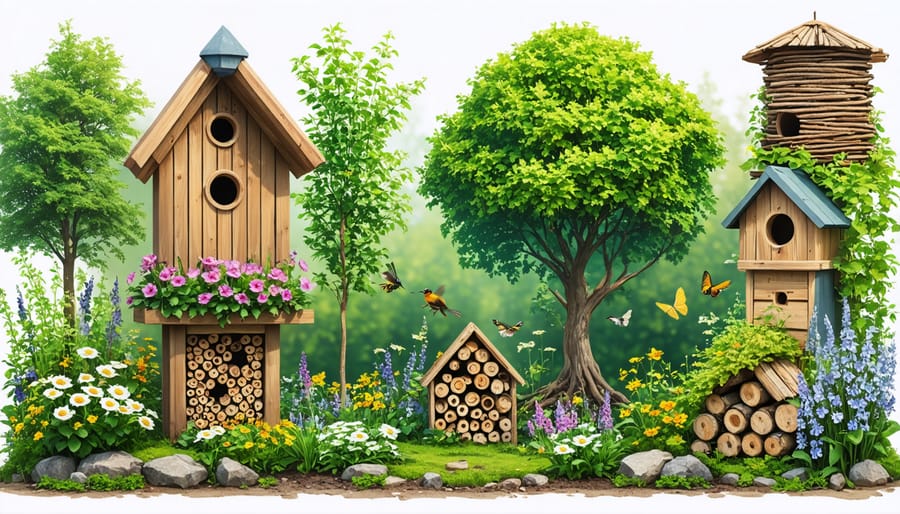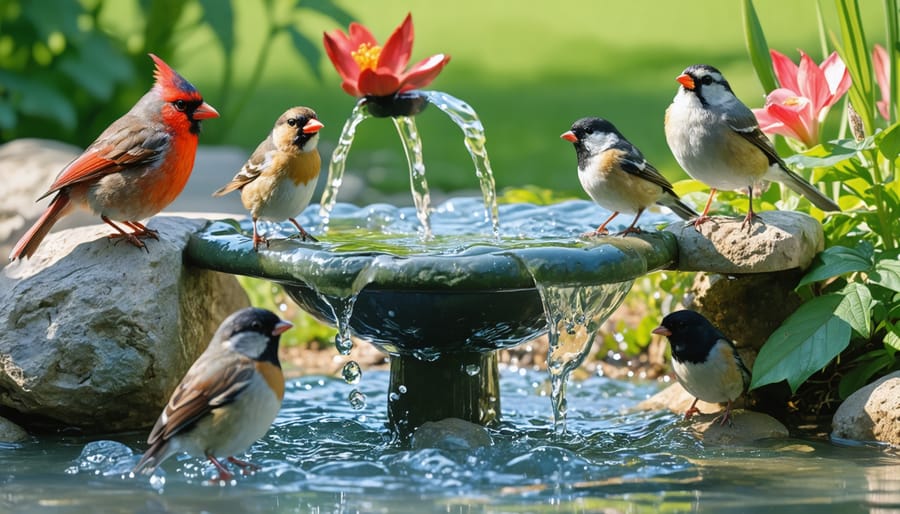Transform your backyard into a vibrant wildlife sanctuary by layering native plants of varying heights – tall trees for nesting birds, flowering shrubs for butterflies, and ground cover for beneficial insects. Add a simple water feature like a shallow basin or small pond to attract diverse species while creating a soothing focal point in your garden. Leave fallen leaves and create brush piles in discrete corners to provide essential shelter and nesting materials for local wildlife. Replace chemical pesticides with companion planting and natural pest control methods, allowing your yard to establish a healthy ecological balance that supports both beauty and biodiversity. Creating a wildlife-friendly space doesn’t mean sacrificing curb appeal – thoughtfully designed natural areas blend seamlessly with traditional landscaping while providing critical habitat for local fauna.
Native Plants: The Foundation of Your Wildlife Sanctuary
Choosing Regional Plants That Attract Local Wildlife
Selecting the right regional plants is the foundation of a thriving wildlife sanctuary in your yard. The key is to focus on native garden design that incorporates plants naturally occurring in your area. These plants have evolved alongside local wildlife, making them perfect food sources and habitat elements.
Start by identifying your local ecosystem and climate zone. Your nearby native plant society or extension office can provide lists of indigenous plants that flourish in your region. Consider creating layers in your garden with trees, shrubs, and ground cover to attract diverse wildlife species.
For birds, include berry-producing shrubs like elderberry or winterberry. Butterflies and bees love native flowering plants such as butterfly weed, black-eyed susans, and bee balm. Don’t forget about host plants – monarch butterflies, for instance, specifically need milkweed for laying eggs.
Group plants with similar water and sunlight needs together, creating natural-looking clusters rather than formal rows. This mimics nature’s patterns and makes your garden more inviting to wildlife. Consider bloom times when selecting plants to ensure year-round food sources for your wild visitors.
Remember that even small spaces can support local wildlife. Container gardens filled with native flowers can attract pollinators, while vertical plantings can provide shelter for birds and beneficial insects. The key is choosing plants that serve multiple purposes – offering food, shelter, and nesting materials throughout the seasons.

Creating Year-Round Food Sources
Creating a continuous food supply for wildlife requires thoughtful planning throughout the seasons. By selecting plants that bloom and produce food at different times, you can attract pollinators year-round while supporting other wildlife species.
Start with early spring bloomers like crocuses and snowdrops, which provide essential nectar for emerging insects. As spring progresses, incorporate flowering shrubs such as lilac and serviceberry. These not only offer nectar but also produce berries that birds love.
For summer, plant a mix of native wildflowers like coneflowers, black-eyed susans, and bee balm. These hardy perennials provide abundant nectar and later produce seeds that sustain birds through fall and winter. Don’t forget to include host plants like milkweed for butterfly larvae!
Fall-blooming asters and goldenrod bridge the gap between seasons, while berry-producing shrubs like winterberry holly and American beautyberry offer crucial winter food sources. Leave seed heads standing on perennials through winter – they’re natural bird feeders!
Consider creating layers in your garden, from ground covers to tall trees. Native oaks support hundreds of species and produce acorns, while fruit trees provide spring blossoms and fall fruits. Remember, even in winter, your garden can provide sustenance through seed heads, berries, and bark that harbors insect larvae.
Water Features That Welcome Wildlife
Safe and Accessible Water Sources
Water is essential for attracting wildlife to your yard, and creating accessible water sources doesn’t have to be complicated. A simple birdbath placed 2-3 feet off the ground can serve as an excellent starting point. Make sure to position it near shrubs or trees where birds can quickly find shelter if needed, but not so close that predators can hide nearby.
For a more natural approach, consider installing a small pond or water garden. Even a container pond using a large pot or basin can create a perfect oasis for wildlife. Add partially submerged rocks or branches to create easy access points for birds, butterflies, and beneficial insects. These landing spots also serve as important safety features, allowing smaller creatures to drink without risking a fall into deeper water.
Remember to maintain your water features regularly. Clean birdbaths weekly and keep moving water features, like small fountains, running to prevent mosquito breeding. During winter, a heated birdbath can provide a crucial water source when natural options freeze. Adding native aquatic plants to ponds not only creates a more natural aesthetic but also helps maintain water quality and provides additional wildlife habitat.

Shelter and Safety: Creating Wildlife Habitats
Natural Cover and Nesting Sites
Creating protective spaces for wildlife is essential for a thriving backyard habitat. Start by layering different heights of native plants, from ground covers to shrubs and trees, which creates a natural corridor for animals to move safely through your yard. Dense shrubs like elderberry or viburnum offer excellent shelter for birds and small mammals, while also providing beautiful foliage and flowers.
Leave fallen leaves and small brush piles in quiet corners of your yard – these create perfect hideaways for beneficial insects, salamanders, and other small creatures. Consider installing birdhouses at varying heights and orientations to accommodate different species. For native bees and other pollinators, maintain some areas of bare soil and consider adding bee houses made from hollow stems or drilled wooden blocks.
Rock gardens and stone walls create excellent micro-habitats for reptiles and amphibians, while also adding architectural interest to your landscape. Allow ornamental grasses to stand through winter, providing both shelter and food sources for birds. If you have dead trees that don’t pose a safety risk, consider keeping them as “snags” – these make perfect homes for woodpeckers, owls, and other cavity-nesting birds.
Remember to position these natural cover elements strategically throughout your yard, creating corridors that connect different habitat areas while maintaining sight lines and the overall aesthetic appeal of your garden.
Building Simple Wildlife Structures
Creating shelter for wildlife can be as simple and rewarding as building a few basic structures in your yard. Let’s start with a classic birdhouse – all you need is some untreated wood, a saw, screws, and basic tools. Build a simple box with a sloped roof, add drainage holes in the bottom, and ensure the entrance hole is appropriately sized for your local bird species. Remember to position it 5-7 feet off the ground, facing away from prevailing winds.
Bee hotels are another fantastic addition to any wildlife-friendly yard. Create one by bundling hollow bamboo stems or drilling holes of varying sizes (between 2-8mm) in a block of untreated wood. Mount your bee hotel in a sunny spot, protected from rain, about 3-5 feet off the ground.
For ground-dwelling creatures, try creating brush piles using fallen branches, leaves, and twigs. Stack them loosely to create hiding spots and shelter for small mammals, reptiles, and beneficial insects. You can also repurpose old terra cotta pots by laying them on their sides and partially burying them to create cozy hideaways for toads and other garden helpers.
Consider adding a log pile in a shady corner – it’s simple but effective. As the wood gradually decomposes, it creates the perfect habitat for beetles, fungi, and other important decomposers that contribute to your garden’s ecosystem.

Sustainable Maintenance Practices
Chemical-Free Pest Management
Managing garden pests doesn’t require harsh chemicals that could harm beneficial wildlife. Instead, focus on harmonious wildlife management by encouraging natural predators and using organic deterrents. Start by attracting insect-eating birds with native plants and appropriate shelter – they’ll help control pest populations naturally.
Companion planting is another effective strategy. Plant aromatic herbs like mint, lavender, and marigolds throughout your garden to naturally repel unwanted insects. For larger pests like rabbits or deer, try planting strongly scented flowers or herbs around the garden’s perimeter.
Create physical barriers using natural materials like copper tape for slug control or floating row covers to protect young plants. A simple solution of mild dish soap and water can deter soft-bodied insects without harming beneficial ones. Coffee grounds scattered around plants help keep slugs at bay while enriching your soil.
Remember that a healthy garden naturally resists pests. Build rich soil with organic compost, maintain proper plant spacing for good air circulation, and water at the base of plants early in the day. These practices create an environment where beneficial insects thrive and problem pests stay manageable.
Creating a wildlife-friendly yard is an enriching journey that benefits both nature and your own well-being. By implementing the strategies we’ve discussed, you’re not just creating a beautiful outdoor space – you’re establishing a thriving ecosystem that supports local wildlife and contributes to biodiversity in your community.
Remember, you don’t need to transform your entire yard overnight. Start small by incorporating native plants, adding a water source, or creating a simple brush pile for shelter. As you witness more birds, butterflies, and beneficial insects visiting your yard, you’ll likely feel inspired to expand your wildlife-friendly features.
The key elements we’ve covered – diverse native plantings, reliable water sources, various shelter options, and sustainable maintenance practices – work together to create a balanced habitat that wildlife will return to season after season. By avoiding pesticides and embracing natural pest control methods, you’re ensuring a safe haven for all creatures that call your yard home.
Your wildlife-friendly yard will evolve with time, becoming more complex and self-sustaining as natural relationships develop between plants and animals. Each small change you make contributes to the larger picture of environmental conservation, while also creating a more engaging and dynamic outdoor space for you to enjoy.
Take that first step today – whether it’s planting a native flower, setting up a bird bath, or leaving a corner of your yard unmowed. Nature will reward your efforts with endless opportunities for discovery and connection.




